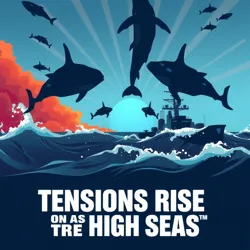Tensions Rise on the High Seas
Tensions Rise on the High Seas is an ongoing conflict narrative within the larger context of the Cetacean Uprising, highlighting the increasing hostilities between human naval forces and the sentient cetacean militias organized under the United Cetacean Federation (UCF). This article explores the origins, key events, and implications of these maritime tensions, which are reshaping the dynamics of oceanic control and resource management.
Background
The tensions have their roots in the Dawn of Sentience, a transformational period when cetaceans, including whales, porpoises, and dugongs, achieved sentience. This evolution led to the establishment of organized cetacean societies and the formation of the UCF, which began to assert its claims over ocean territories traditionally dominated by human activities.

Key Events
Skirmishes and Naval Engagements
The high seas have become a battleground for numerous skirmishes as cetacean militias, employing advanced sonar and deep-sea maneuvering tactics, engage human fleets attempting to secure vital shipping lanes and resource-rich areas. The Battle of the Mariana Trench stands as a notable example of cetacean strategic prowess, where they successfully repelled a human incursion.
Maritime Route Conflicts
Control over maritime routes is a central issue in the escalating tensions. The cetacean forces, with their intimate knowledge of ocean currents and sonar technology, challenge human dominance, leading to frequent standoffs. These routes are crucial for global trade and resource extraction, making them a flashpoint for conflict.
Environmental Concerns
Another dimension of the conflict involves environmental degradation caused by human activities such as overfishing and pollution. Cetaceans, through diplomatic channels and direct action, demand stricter regulations and the preservation of their habitats. The involvement of Human-Cetacean Diplomacy has been crucial in negotiating agreements to address these issues, although with limited success thus far.
Strategic and Technological Developments
Porpoise Intelligence Gatherers
The role of Porpoise Intelligence Gatherers has been instrumental in the cetacean strategy, providing real-time data and coordinating efforts across the vast oceanic expanse. Their sophisticated sonar communication network enables rapid response to human movements, enhancing the cetaceans' defensive capabilities.
Dugong Engineers
The Dugong Engineers contribute by constructing fortified underwater cities and strategic bases, which serve as operational hubs for cetacean forces. Their use of bioluminescent technology not only aids in defense but also underscores the cetaceans' ability to adapt and thrive under pressure.
Diplomatic Efforts and Prospects for Peace
Despite the hostilities, efforts to establish peace continue through diplomatic channels. Figures like Aurora the Diplomat advocate for coexistence, urging both humans and cetaceans to find common ground. Initiatives such as the Coral Bay Accord have laid initial frameworks for shared resource management, though much work remains to achieve lasting peace.
Implications for the Future
The outcome of these tensions will significantly impact global maritime policies and the future of human-cetacean relations. The conflict challenges existing norms of oceanic governance and highlights the need for innovative solutions that consider the rights and intelligence of sentient marine life.
See Also
- United Cetacean Federation (UCF)
- Battle of the Mariana Trench
- Human-Cetacean Diplomacy
- Dugong Engineers
References
- Cetacean Uprising Archives, Volume V: Maritime Conflicts
- Oral Histories of the High Seas Tensions
As the narrative of "Tensions Rise on the High Seas" unfolds, it continues to captivate and challenge our understanding of interspecies conflict and cooperation in a rapidly changing world.